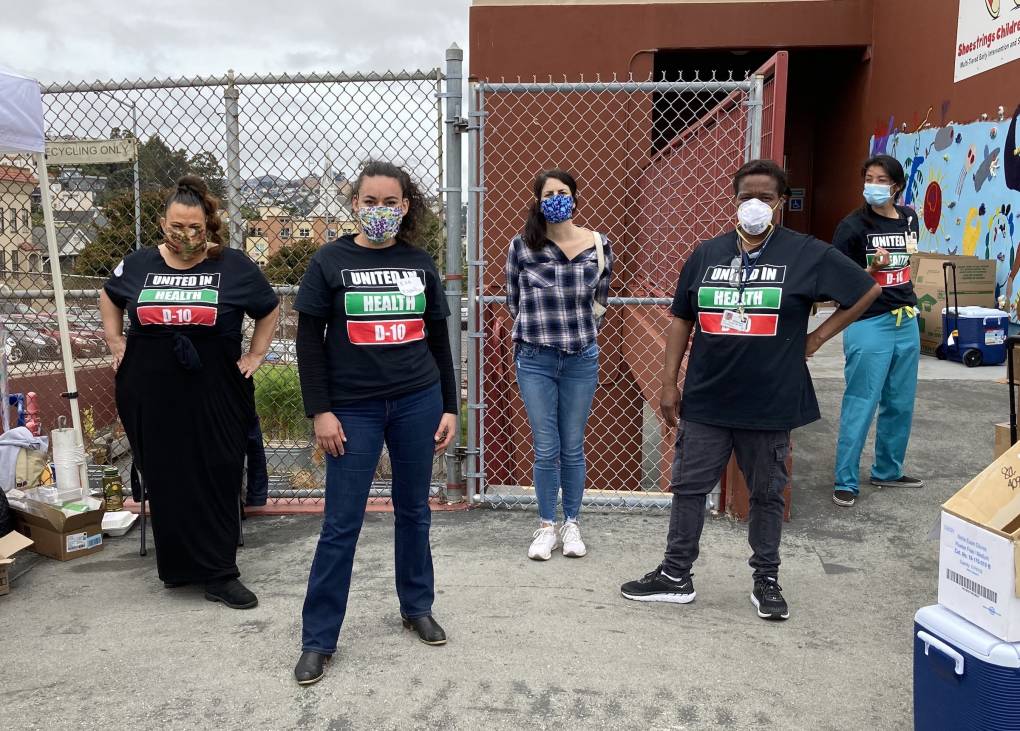Community-Led Effort Brings Free COVID-19 Testing to SF’s Bayview, Visitacion Valley

Volunteers prepare to test Bayview residents on Saturday. (Courtesy of Maria Victoria Rosales)
June 2, 2020
While protesters flooded the streets of cities across the country this weekend, community groups set up medical tents and distributed hand sanitizer at the playground of Leola M. Havard Early Education School in San Francisco’s Bayview neighborhood.
It was the first two days of COVID-19 testing in San Francisco’s District 10 — which includes parts of the Bayview-Hunters Point and Visitacion Valley neighborhoods — the result of weeks of coordination between community advocates, UCSF doctors and city agencies.
The work follows last month’s United in Health initiative to test every resident of the Mission District, part of an effort to better understand how the virus spreads in some of San Francisco’s most vulnerable communities.
But no one involved in the new testing program anticipated it would launch in the middle of nationwide protests against police violence following the death of George Floyd, a black man killed by Minneapolis police on May 25, 2020.
“Resources are being really challenged,” said Monique LeSarre, executive director of the Rafiki Coalition for Health and Wellness. “What COVID-19 has brought to the community is that we are already pressed. And now we’re really pressed.”
Despite the unrest, at least 850 people in the neighborhood turned out over the weekend to get tested. UCSF conducted both viral and antibody tests, working with the San Francisco Department of Public Health and other city agencies.
“This is how we’re going to get a handle on just how deep the virus is in our community,” said Michelle Pierce, executive director of Bayview Hunters Point Community Advocates, who helped organize the initiative. “And this is how we are going to slow and hopefully stop its progression completely throughout our community.”
Testing continues Monday and Tuesday at Herz Playground in Visitacion Valley. Additional testing will also be available for unhoused residents of District 10, as well as the people who assist them. The project is hoping to test a total of about 5,000 neighborhood residents.
District 10, home to San Francisco’s largest African American population, is among the lowest-income district’s in the city. It also has some of the highest reported rates of COVID-19 citywide, in addition to disproportionately higher rates of hospitalizations due to asthma, heart disease, diabetes and breast cancer.
“Disparities are not new,” said Dr. Kim Rhoads, professor of epidemiology and director of the Office of Community Engagement at UCSF, who helped implement the Bayview testing effort. “Coronavirus has really ripped the lid off of it.”
Rhoads said she thinks this kind of partnership with community organizations is vital to solving some of the biggest public health crises, including cancer, diabetes, asthma — and now, COVID-19. Too often, she says, medical institutions come up with solutions on their own that fall short of meeting the needs of specific communities.
“It’s rare that we ask the community, how should we do this?” Rhoads said. “We’ve been doing work on the cancer side for decades. And some of the disparities in terms of survival have gotten worse. It means we’re missing the mark in terms of our intervention.”
She added, “If we apply this kind of approach to other types of diseases we’re going to get different outcomes.”
The testing program in District 10 has focused on developing new ways that medical institutions can work with disenfranchised communities — one rooted in asking advocates for input and working with community organizers, like Pierce and LeSarre, to build trust and buy-in.
Pierce says that kind of engagement and outreach is essential for coronavirus testing to be successful in her community, which she says lacks trust in medical institutions and health experts.
“Let’s talk about stuff like medical experimentation during slavery and the Tuskegee syphilis studies and Henrietta Lacks,” Pierce said. That history of racial exploitation influences and shapes how her community interacts with medical institutions, she says, and results in a lack of trust and hesitation to go out, get tested and interact with bureaucracy.
“It’s a very fraught, very interesting relationship,” Pierce said. To overcome that, “you need community in the lead,” she added. “You need to have them driving the process and you need to stop and listen to them.”
Rhoads turned to Pierce and LeSarre for input about where to locate the testing sites and which groups of residents to reach out to. Collectively, they picked the site in Bayview and one in Visitacion Valley, and opened up test screening to anyone who “works, stays, plays or prays” in the area. Pierce and LeSarre have also coordinated dozens of volunteers across the district.
Dr. Margot Kushel, a UCSF professor who is coordinating next week’s effort to test unhoused residents in the district, says doing this work against the backdrop of mass protests underscores why it matters now more than ever.
“We’ve seen that the toll of racism plays out in the incredibly disproportionate burden of COVID in black communities, Latinx communities and other communities of color in this country,” she said.
UCSF said it expects to return viral testing results in a matter of days, with those who test positive given the resources needed to self-isolate. The team plans to conduct extensive contact tracing efforts, too.
“There’s no perfect solution for stuff like homelessness or international pandemics,” Pierce, of Bayview Hunters Point Community Advocates, said. “These are really complicated issues. It takes complex, very flexible relationships in order to solve them.”
To volunteer or learn more about next weekend’s United in Health Unhoused Initiative, click here.

